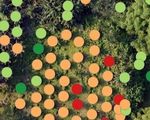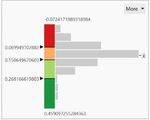UAV application to estimate oil palm trees health using Visible Atmospherically Resistant Index VARI Case study of Cikabayan Research Farm ...
←
→
Page content transcription
If your browser does not render page correctly, please read the page content below
E3S Web of Conferences 211, 05001 (2020) https://doi.org/10.1051/e3sconf/202021105001
The 1st JESSD Symposium 2020
UAV application to estimate oil palm trees health
using Visible Atmospherically Resistant Index
(VARI) (Case study of Cikabayan Research Farm,
Bogor City)
Medina Nur Anisa1, Rokhmatuloh1*, and Revi Hernina1
1Department of Geography, Faculty of Mathematics and Natural Science, Universitas Indonesia,
Depok, 16424, Indonesia
Abstract. This article describes the making of an oil palm tree health map
using aerial photos extracted from UAV DJI Phantom 4. A DJI Phantom 4
was flown at 100 meters height at the Cikabayan Research Farm, Bogor
City. Raw aerial photos from DJI Phantom 4 were processed using Agisoft
Photoscan software to generate dense point clouds. These points were
computed to produce a digital surface model (DSM) and orthophotos with a
spatial resolution of 2.73 cm/pixel. Red, green, and blue bands of the photos
were computed to provide the Visible Atmospherically Resistant Index
(VARI). Also, orthophotos containing oil palm trees were digitized to create
points in vector form. VARI pixel values were added to each point and
classified into four classes: Needs Inspection, Declining Health, Moderately
health, and Healthy. Resulted oil palm tree health map reveals that most of
the oil palm trees in the study location are classified as Declining Health and
Needs Inspection. Profitably, plantation workers can directly inspect oil
palm trees whose health are declining, based on information derived from
oil palm tree health map. The information that comes from this study will
significantly save time and effort in monitoring oil palm trees' healthiness.
1 Introduction
The development of oil palm plantations is a strategic issue that encourages and improves
the community's welfare, the national economy, and makes Indonesia the largest producer of
palm oil [1]. It is envisaged that the development of oil palm plantations can open up business
opportunities and increase employment. With this development, it is not surprising that the
Indonesian palm oil industry has become a topic of interest to the world community.
Trees maintenance is crucial to determine whether the plants are healthy or sick to
increase oil palm plantations. Plants with the disease will be treated or replaced with new
plants to increase oil palm production. Monitoring oil palm plantations traditionally will
require a lot of time and effort. Therefore cheaper and more efficient technological
innovations are needed.
* Corresponding author: rokhmatuloh.ssi@sci.ui.ac.id
© The Authors, published by EDP Sciences. This is an open access article distributed under the terms of the Creative Commons
Attribution License 4.0 (http://creativecommons.org/licenses/by/4.0/).E3S Web of Conferences 211, 05001 (2020) https://doi.org/10.1051/e3sconf/202021105001
The 1st JESSD Symposium 2020
Unmanned Aerial Vehicles (UAV) or Drone mapping technology is an alternative option
besides other mapping technologies such as large and manned aerial photography and
satellite-based mapping. UAV is a type of aircraft controlled by a remote control system tool
via radio waves. The UAV is an electro-mechanical-based system that can carry out
programmed missions with the characteristics of a flying machine that functions remotely by
the pilot or can control himself, using aerodynamics' laws to lift himself [2].
UAV technology can be used to estimate vegetation cover [3], monitoring forest
rehabilitation [4], forest fires [5], and monitoring forest health [6]. The drone has many
advantages when compared to other remote sensing platforms such as planes and satellites.
These advantages include cloud-free images and higher spatial resolution. UAV technology
has the potential to be used for particular mapping purposes in agriculture [7]. Considering
all the benefits mentioned earlier and the advantages of UAVs, this study uses UAVs' ability
to monitor the health of oil palm trees. Not to mention that UAV applications can save time
and increase productivity. Therefore, this study aims to estimate oil palm trees' health using
the Visible Atmospheric Resistant Index (VARI) by utilizing aerial mapping technology.
2 Method
In this study, the oil palm plantations will be monitored using visible wavelengths generated
from Unmanned Aerial Vehicles (UAV). The visible wavelengths were processed to generate
the Visible Atmospherically Resistant Index (VARI), which would be used as a health
indicator of oil palm trees.
2.1 Research locations
Cikabayan Research Farm is located at 6°33'5.06"S and 106°43'3.78"E. It is relatively close
to the IPB University campus, close to the housing for lecturers (Figure 1). When seen in
Figure 1, Cikabayan Research Farm is located north of the IPB University campus. This
research farm has the largest area when compared to other research farms. Cikabayan
Research Farm has around 22 hectares with a significant land area of approximately 5
hectares.
Fig. 1. Map of Research Location (Cikabayan Research Farm). (source: Google Earth)
2E3S Web of Conferences 211, 05001 (2020) https://doi.org/10.1051/e3sconf/202021105001
The 1st JESSD Symposium 2020
2.2 Field data
In recording field data using a rotor type UAV [8], a DJI Phantom 4 was flown in the study
area (Figure 2). Before recording, a flight path was planned using the Pic 4D application on
the mobile phone (Figure 3). This recording time took 9 minutes with a flying altitude of 100
meters above ground to get detailed and precise data with a spatial resolution of 2.73
cm/pixel.
Fig. 2. DJI Phantom 4. (Personal Data)
Fig. 3. Flightpath mission planning on Pic 4D mobile application. (Data Processing)
2.3 Data processing
After the recording phase, a JPEG format photo was obtained equipped with geographic
coordinates. Approximately 80 photos were acquired from the UAV flight and combined
using a photo mosaic process in the Agisoft Photoscan software. Combined photos were
aligned to create dense point clouds. These points were calibrated to generate a mesh that
provided a digital surface model (DSM) [9] and orthophotos. Orthophotos were converted
into a tiff file extension using ArcGIS Pro software.
3E3S Web of Conferences 211, 05001 (2020) https://doi.org/10.1051/e3sconf/202021105001
The 1st JESSD Symposium 2020
Fig. 4. The orthophoto in .tiff file. (Data Processing)
2.4 Digitizing oil palm trees
The orthophoto was digitized using ArcGIS Pro software to create and manage label objects
[10]. All oil palm trees were digitized to generate circular polygons based on the size, shape,
and characteristics extracted from aerial photographs. Next, digitized polygons were
extracted into points and saved.
Fig. 5. Digitized polygons of all oil palm trees. (Data Processing)
2.5 Raster processing
After the digitization process was completed, the next process was to estimate oil palm trees'
health using VARI. VARI is an indirect measure developed from the Leaf Area Index (LAI)
and Vegetation Fraction (VF) based on visible wavelengths' reflectance values. VARI can be
calculated using the following formula:
VARI = (Rg - Rr) / (Rg + Rr - R(Rg - Rb))
4E3S Web of Conferences 211, 05001 (2020) https://doi.org/10.1051/e3sconf/202021105001
The 1st JESSD Symposium 2020
Rr, Rg, and Rb reflect values for the red, green, and blue bands, respectively [11].
Fig. 6. Map with VARI pixel values. (Data Processing)
A raster function containing band arithmetic was used to display the map resulted from VARI
computation. Parameters containing the VARI method were selected in the analysis step.
When the parameter index shows red, green, and blue bands, fill in the index band with 1 for
red, 2 for green, and 3 for blue. The standard deviation menu was chosen to increase the
sharpness of the stretched image.
A raster map showing VARI was beneficial but could not be used to determine which
trees need maintenance. Hence, it was necessary to have the average VARI value for each
tree by extracting the VARI raster map using circular polygons. It could finally show healthy
trees and which trees needed treatment.
3 Results and discussion
Resulted from VARI values are divided into four classes: Needs Inspection, Declining
Health, Moderately health, and Healthy. Furthermore, each class is symbolized by gradation
colors (red-yellow-green) to differentiate healthy trees from trees that need maintenance
(Figure 8). The resulting oil palm tree health map in the Cikabayan Research Farm reveals
that most oil palm trees are in Declining Health and Needs Inspection. Plantation workers
can directly inspect oil palm trees whose health is declining, based on information derived
from oil palm tree health map. The information that comes from this study will significantly
save time and effort in monitoring oil palm trees' health.
Fig. 7. The process of Vegetation Health Estimation (VARI, Extract, and Classes). (Data
Processing)
5E3S Web of Conferences 211, 05001 (2020) https://doi.org/10.1051/e3sconf/202021105001
The 1st JESSD Symposium 2020
Fig. 8. Oil palm tree health map. (Data Processing)
4 Conclusion
The conclusion of this research is that the health of oil palm plants can be detected by utilizing
aerial photographic images taken with UAV DJI Phantom 4 by calculating the Visible
Atmospherically Resistant Index (VARI). If the plant is quickly detected as unhealthy, it will
be quickly checked. So that aerial photography technology will save time and effort in
monitoring the health of oil palm.
References
1. USDA. The Natural Resources Conservation Service 2019: The PLANTS Database
National Plant Data Team Greensboro NC 27401-4901 (2019)
2. H.S. Saroinsong, V.C. Poekoel, and P.D. Manembu, Design of Unmanned Aircraft
Vehicle Based on Ardupilot, Journal of Electrical and Computer Engineering. 7, 1
(2018)
3. R.P. Breckenridge, and M. E. Dakins, Evaluation of bare ground on rangelands
using unmanned aerial vehicles: A case study GIScience, Remote Sensing. 48, 12
(2011)
4. J.N. Hird, A. Montaghi, G.J. McDermid, J. Kariyeva, B.J. Moorman, S.E. Nielsen
and A.C.S. McIntosh, Use of unmanned aerial vehicles for monitoring recovery of
forest vegetation on petroleum well sites, Remote Sensing. 9, 413 (2017)
5. V.G. Ambrosia, S.S. Wegener, D.V. Sullivan, S.W. Buechel, S.E. Dunagan, J.A.
Brass, and S.M. Schoenung, Demonstrating UAV-acquired real-time thermal data
over fires, Photogramm. Eng. Remote Sens. 69, 4 (2003)
6. J.P. Dash, M.S. Watt, G.D. Pearse, M. Heaphy, and H.S. Dungey, Assessing very
high-resolution UAV imagery for monitoring forest health during a simulated
disease outbreak ISPRS, Journal of Photogrammetry and Remote Sensing 131
(2017)
7. C.A. Rokhmana, The Potential of UAV-based Remote Sensing for Supporting
Precision Agriculture in Indonesia in Ist International Symposium on LAPAN-IPB
Satellite (2014)
6E3S Web of Conferences 211, 05001 (2020) https://doi.org/10.1051/e3sconf/202021105001
The 1st JESSD Symposium 2020
8. H.A. Afif, R. Saraswati, and R. Hernina, UAV Application for Landslide Mapping
in Kuningan Regency, West Java in E3S Web of Conferences EDP Sciences. 125
(2019)
9. A. Syetiawan, and H. Gularso, Establishment of DSM Using Unmanned Aircraft
System (UAS) and Non-Metric Digital Cameras in the National Seminar on
Geography and Sustainable Development. (2018)
10. ArcGIS Learn, https://learn.arcgis.com/
11. A.A. Gitelson, Y.J. Kaufman, R. Stark, and D. Rundquist Novel algorithms for
remote estimation of vegetation fraction, Remote sensing of Environment. 80, 1
(2002)
7You can also read


























































